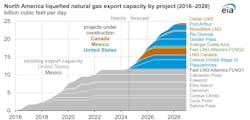EIA: North America’s LNG export capacity to more than double by 2028
North America's LNG export capacity is on track to more than double to 24.4 bcfd by 2028 from 11.4 bcfd in 2023 if projects currently under construction begin operations as planned, according to data from the US Energy Information Administration (EIA).
“During this period, we anticipate that developers in Mexico and Canada will launch their first LNG export terminals, while the US will expand its existing LNG capacity. By the end of 2028, we estimate LNG export capacity will increase by 0.8 bcfd in Mexico, 2.5 bcfd in Canada, and 9.7 bcfd in the US, thanks to 10 new projects currently under construction across the three countries,” EIA said.
In Mexico, developers are currently constructing two projects with a combined LNG export capacity of 0.6 bcfd—Fast LNG Altamira offshore on Mexico's east coast and Energía Costa Azul on Mexico's west coast. Fast LNG Altamira consists of two floating LNG production units (FLNG), each with a capacity to liquefy up to 0.199 bcfd of natural gas, off the coast of Altamira, Tamaulipas, Mexico. Natural gas from the US delivered via the Sur de Texas-Tuxpan pipeline will supply these units. The first LNG cargo from the unit was shipped in August 2024.
The Energía Costa Azul LNG export terminal (0.4 bcfd export capacity) is sited at the existing LNG regasification terminal in Baja California in western Mexico. Developers have proposed an expansion of 1.6 bcfd in Phase 2. The project will be supplied with natural gas from the US Permian basin.
Developers have proposed other LNG export projects, all for Mexico’s west coast, including Saguaro Energia LNG (2.0 bcfd), Amigo LNG (1.0 bcf/d), Gato Negro LNG (0.6 bcfd), Salina Cruz LNG (0.4 bcfd), and Vista Pacifico LNG (0.5 bcfd), with a combined capacity of 4.5 bcfd; however, none of these projects have reached a final investment decision or started construction.
In Canada, three LNG export projects with a combined capacity of 2.5 bcfd are under construction in British Columbia on Canada’s west coast. Developers of LNG Canada (1.8 bcfd) plan to start LNG exports from Train 1 in the summer of 2025. Woodfibre LNG (0.3 bcfd) targets the startup of LNG exports in 2027. Cedar LNG—an FLNG project with capacity to liquefy up to 0.4 bcfd—made a final investment decision in June 2024 and expects to start LNG exports in 2028. These projects will be supplied with natural gas from western Canada.
In addition, the Canada Energy Regulator (CER) has authorized four LNG export projects, including an expansion of LNG Canada, with a combined proposed LNG export capacity of 4.1 bcfd.
In the US, five LNG export projects are currently under construction with a combined export capacity of 9.7 bcfd—Plaquemines (Phase I and Phase II), Corpus Christi Stage III, Golden Pass, Rio Grande (Phase I), and Port Arthur (Phase I). Developers expect to produce first LNG from Plaquemines LNG and Corpus Christi LNG Stage III and ship first cargoes from these projects by yearend.
